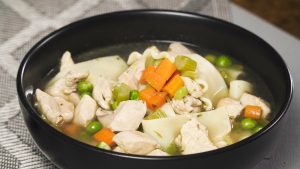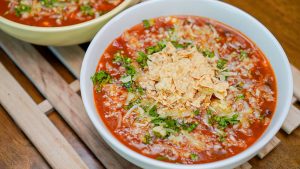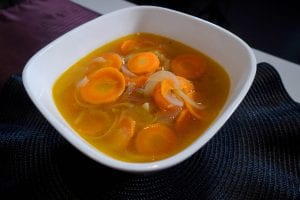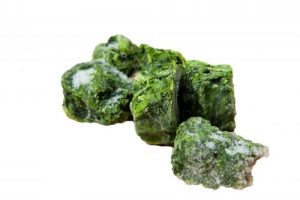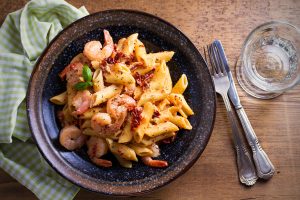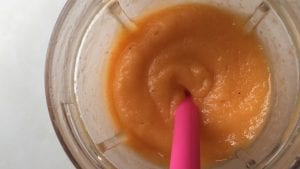Dive into the exquisite flavors of Southeast Asia with this Thai Coconut Curry Chicken Soup recipe. A savory melody of traditional Thai ingredients creates a soup that is rich in texture and brimming with spices. Ideal for both cozy family dinners and adventurous dinner parties, this recipe promises a fulfilling culinary journey.
This recipe includes some ingredients that might be new to some cooks, such as the red curry paste, fish sauce, and pad thai rice noodles. These are staple ingredients in Thai cuisine and can usually be found in the international or Asian section of most supermarkets. The red curry paste offers a robust flavor and a spicy kick to the dish. The fish sauce, on the other hand, is a condiment made from fish that has been coated in salt and fermented for up to two years, adding a distinctive umami flavor. Pad Thai rice noodles are thin, flat rice noodles that are a common component in Thai dishes.
Ingredients for Thai Coconut Curry Chicken Soup
Pad Thai rice noodles: These are thin, flat rice noodles that are commonly used in Thai dishes.
Olive oil: Used for sauteing the ingredients.
Yellow onion: Adds a sweet and tangy flavor to the soup.
Garlic: Adds a pungent and spicy flavor.
Curry powder and red curry paste: Gives the soup its distinctive curry flavor.
Turmeric: Adds a warm, bitter flavor and a vibrant color.
Ground coriander: Adds a slightly sweet and citrusy flavor.
Red bell pepper: Adds a sweet and slightly tangy flavor.
Low-sodium chicken broth: Forms the base of the soup.
Coconut milk: Gives the soup a creamy texture and a sweet flavor.
Rotisserie chicken: Adds a savory and hearty element to the soup.
Snow peas: Provides a crunchy texture.
Light-brown sugar: Enhances the sweetness of the soup.
Fish sauce: Adds a unique umami flavor.
Green onions: Adds a mild onion flavor and a pop of color.
Fresh spinach: Adds a mild flavor and a variety of nutrients.
Fresh cilantro: Adds a fresh and citrusy flavor.
Fresh lime juice: Adds a tangy flavor that brightens up the soup.
Peanuts and red chili pepper: Used for garnishing.
One reader, Darleen Talbot says:





This Thai coconut curry chicken soup recipe is a game-changer! The flavors are incredibly rich and aromatic, and the combination of spices is just perfect. It's a comforting and satisfying dish that's easy to make. I highly recommend it for anyone looking to add some excitement to their mealtime!
Techniques Required for Thai Coconut Curry Chicken Soup Recipe
How to prepare the rice noodles: Boil 4 cups of water in a large saucepan. Add the rice noodles and cook for 3 to 6 minutes, following the package instructions. Drain and rinse with cold water.
How to sauté the aromatics: Heat oil in a large pot over medium-high heat. Sauté the onion for 3 minutes, then add garlic, curry powder, curry paste, turmeric, and coriander. Sauté for 1 minute, then add the bell pepper and sauté for an additional minute.
How to simmer the soup: After adding the chicken broth, bring it to a boil. Then stir in the coconut milk, cover, reduce the heat to low, and simmer for 10 minutes.
How to incorporate the chicken and vegetables: After simmering, stir in the chicken, snow peas, brown sugar, fish sauce, and green onions. Season with salt and cook for an additional 2 minutes.
How to finish the soup: Stir in the spinach, cilantro, and lime juice, and cook until the spinach wilts. Toss in the cooked rice noodles.
How to serve: Serve the soup warm, garnished with peanuts and sliced red chili pepper.
How To Make Thai Coconut Curry Chicken Soup
Bring the taste of Thai flavors to your home with this coconut curry chicken soup recipe. The vibrant Thai flavors in this dish are just so irresistible.
Serves:
Ingredients
- 6ozpad thai rice noodles
- 2tbspolive oil or canola oil, divided
- 1cupyellow onionfinely chopped
- 1 ½tbspgarlic minced
- 2tspcurry powder
- 2tspred curry paste
- ½tspturmeric
- ½tspground coriander
- 1redbell peppersliced into small, thin strips
- 6cupslow-sodium chicken broth
- 1canregular coconut milkor light coconut milk
- 3cupsrotisserie chickenshredded, cooked
- 8ozsnow peastrimmed and sliced in half crosswise
- 2tbsplight-brown sugar
- 2tbspfish sauce
- ½cup green onionschopped
- salt
- 5ozfresh spinach4 packed cups
- ½cupfresh cilantrochopped
- 2tbspfresh lime juice
For serving:
- peanutschopped
- 1red chili pepperseeded and chopped or sriracha
Instructions
-
Bring 4 cups of water to a boil in a large saucepan. Once boiling adds rice noodles and boils according to directions on the package for about 3 to 6 minutes. Drain and rinse with cold water.
-
Heat 1 tablespoon oil in a large pot over medium-high heat. Add onion and saute 3 minutes then add another ½ tablespoon oil, garlic, curry powder, curry paste, turmeric, and coriander.
-
Saute 1 minute then add last ½ tablespoon oil and bell pepper and saute 1 minute. Stir in chicken broth and bring to a boil.
-
Stir in coconut milk, cover, reduce heat to low, and simmer 10 minutes. Stir in chicken, snow peas, brown sugar, fish sauce, and green onions.
-
Season with salt to taste and cook for 2 minutes. Stir in spinach, cilantro, and lime juice and cook until spinach wilts.
-
Toss in noodles. Serve warm with peanuts and red peppers.
Nutrition
- Calories: 594.35kcal
- Fat: 32.92g
- Saturated Fat: 17.66g
- Trans Fat: 0.07g
- Monounsaturated Fat: 9.45g
- Polyunsaturated Fat: 3.56g
- Carbohydrates: 53.69g
- Fiber: 8.05g
- Sugar: 10.25g
- Protein: 27.04g
- Cholesterol: 52.66mg
- Sodium: 1569.23mg
- Calcium: 210.74mg
- Potassium: 1336.33mg
- Iron: 9.47mg
- Vitamin A: 300.39µg
- Vitamin C: 97.21mg
Crucial Technique Tip for Thai Coconut Curry Chicken Soup Recipe
When preparing the Thai Coconut Curry Chicken Soup, it's important to add the spinach towards the end of the cooking process. This ensures that the spinach maintains its vibrant green color and doesn't overcook, which can result in a wilted and unappetizing texture. Similarly, adding the lime juice at the end helps to preserve its fresh and tangy flavor, which can be lost if it's cooked for too long.
Time-Saving Tips for Making Thai Coconut Curry Chicken Soup
Prep ahead: Chop vegetables and measure out ingredients in advance to streamline the cooking process.
Use rotisserie chicken: Save time by using pre-cooked rotisserie chicken instead of cooking and shredding chicken from scratch.
Invest in a good knife: A sharp, quality knife can make chopping and prepping ingredients much quicker and more efficient.
Organize your workspace: Keep your cooking area clean and organized to minimize time spent searching for utensils and ingredients.
Multi-task: While one component is cooking, use that time to prep other ingredients to maximize efficiency in the kitchen.
Substitute Ingredients For Thai Coconut Curry Chicken Soup Recipe
pad thai rice noodles - Substitute with vermicelli rice noodles: Vermicelli rice noodles are a suitable substitute for pad thai rice noodles, offering a similar texture and ability to absorb flavors in the soup.
yellow onion - Substitute with white onion: White onions can be used as a substitute for yellow onions, providing a slightly milder flavor but still adding depth to the soup.
garlic - Substitute with garlic powder: If fresh garlic is not available, garlic powder can be used as a substitute, although the flavor profile may be slightly different.
curry powder - Substitute with garam masala: Garam masala can be used as a substitute for curry powder, providing a warm and aromatic flavor to the soup.
red curry paste - Substitute with yellow curry paste: Yellow curry paste can be used as a substitute for red curry paste, offering a similar flavor profile with a slightly milder heat.
turmeric - Substitute with ground ginger: Ground ginger can be used as a substitute for turmeric, providing a warm and earthy flavor to the soup.
ground coriander - Substitute with cumin: Cumin can be used as a substitute for ground coriander, adding a warm and slightly nutty flavor to the soup.
red bell pepper - Substitute with orange bell pepper: Orange bell pepper can be used as a substitute for red bell pepper, providing a similar sweet and crisp texture to the soup.
low-sodium chicken broth - Substitute with vegetable broth: Vegetable broth can be used as a substitute for chicken broth, providing a flavorful base for the soup while catering to vegetarian preferences.
regular coconut milk - Substitute with light coconut milk: Light coconut milk can be used as a substitute for regular coconut milk, offering a lower-fat alternative without compromising the creamy texture.
rotisserie chicken - Substitute with tofu cubes: Tofu cubes can be used as a substitute for rotisserie chicken, providing a vegetarian-friendly protein option for the soup.
snow peas - Substitute with sugar snap peas: Sugar snap peas can be used as a substitute for snow peas, offering a similar crunchy texture and sweet flavor to the soup.
light-brown sugar - Substitute with honey: Honey can be used as a substitute for light-brown sugar, adding a natural sweetness to the soup.
fish sauce - Substitute with soy sauce: Soy sauce can be used as a substitute for fish sauce, providing a savory and umami flavor to the soup.
green onions - Substitute with chives: Chives can be used as a substitute for green onions, offering a mild onion flavor and a pop of color as a garnish for the soup.
fresh spinach - Substitute with kale: Kale can be used as a substitute for fresh spinach, providing a hearty and nutritious green component to the soup.
fresh cilantro - Substitute with fresh parsley: Fresh parsley can be used as a substitute for cilantro, offering a similar bright and herbaceous flavor to the soup.
fresh lime juice - Substitute with lemon juice: Lemon juice can be used as a substitute for fresh lime juice, providing a tangy and citrusy element to the soup.
Presentation Tips for Thai Coconut Curry Chicken Soup
Elevate the plating: When presenting the Thai coconut curry chicken soup, ensure that the bowl is clean and free of any smudges. The soup should be the focal point, so use a wide, shallow bowl to showcase the vibrant colors and textures of the dish.
Garnish with precision: Sprinkle a handful of fresh cilantro leaves over the soup, ensuring that they are evenly distributed. The bright green color will provide a striking contrast against the rich, creamy broth.
Create a symmetrical arrangement: Place a small pile of julienned red chili peppers in the center of the soup. This not only adds a pop of color but also hints at the dish's spiciness, setting the stage for the complex flavors to come.
Incorporate texture: Sprinkle crushed peanuts over the soup, adding a delightful crunch to each spoonful. The contrast in texture will elevate the overall dining experience.
Balance the elements: Arrange a few whole snow peas on top of the soup, strategically placing them to create a sense of balance and harmony. This adds a touch of elegance to the presentation.
Highlight the noodles: Carefully drape a small portion of the cooked pad thai rice noodles over the soup, allowing them to cascade gently down the side of the bowl. This not only adds visual appeal but also showcases the key ingredient in the dish.
Essential Kitchen Tools for Making Thai Coconut Curry Chicken Soup
Saucepan: A deep cooking pan with a handle and a lid, used for boiling, simmering, and making sauces.
Large pot: A deep, wide container with a handle and often a lid, used for cooking soups, stews, and boiling pasta.
Large saucepan: Similar to a regular saucepan, but with a larger capacity, used for making large batches of soups, stews, and sauces.
Colander: A bowl-shaped kitchen utensil with perforated holes used to drain liquids from food, such as pasta or vegetables.
Mixing spoon: A long-handled spoon used for mixing and stirring ingredients in cooking and baking.
Chef's knife: A versatile, all-purpose kitchen knife with a broad blade used for chopping, slicing, and dicing.
Cutting board: A durable board used as a surface for cutting and preparing ingredients.
Measuring cups and spoons: Tools used for accurately measuring ingredients in cooking and baking.
Ladle: A long-handled spoon with a deep bowl, used for serving soups, stews, and sauces.
Tongs: Kitchen utensils with two arms and a pivot used for picking up and manipulating food.
Grater: A kitchen utensil with sharp-edged perforations used for shredding or grating food items.
Peeler: A tool used for removing the outer skin or peel of fruits and vegetables.
Strainer: A kitchen tool used for separating liquids from solid ingredients.
Soup ladle: A large, deep spoon with a long handle, used for serving soup.
Knife: A sharp-edged utensil used for cutting and preparing ingredients.
Spatula: A flat, flexible kitchen tool used for lifting, flipping, and spreading ingredients.
Grater: A kitchen tool with sharp-edged holes used for shredding or grating food items.
Citrus juicer: A tool used for extracting juice from citrus fruits.
Soup bowls: Bowls used for serving the prepared soup.
Chopping board: A durable board used as a surface for cutting and preparing ingredients.
Soup bowls: Bowls used for serving the prepared soup.
Pepper mill: A tool used for grinding peppercorns to add freshly ground pepper to dishes.
Measuring spoons: Tools used for accurately measuring small amounts of ingredients in cooking and baking.
Can opener: A tool used for opening cans of ingredients, such as coconut milk.
Serving bowls: Bowls used for serving the prepared soup.
Soup ladle: A large, deep spoon with a long handle, used for serving soup.
Soup bowls: Bowls used for serving the prepared soup.
Storing and Freezing Thai Coconut Curry Chicken Soup
- Let the Thai coconut curry chicken soup cool completely before storing or freezing.
- Transfer the cooled soup to an airtight container or a freezer-safe bag. If using a bag, remove as much air as possible before sealing to prevent freezer burn.
- Label the container or bag with the date and contents for easy identification.
- Refrigerator storage: The soup can be stored in the refrigerator for up to 4 days. Reheat gently on the stovetop or in the microwave before serving.
- Freezer storage: The soup can be frozen for up to 3 months. When ready to eat, thaw the soup overnight in the refrigerator.
- For best results, store the rice noodles separately from the soup. Cook fresh noodles when reheating the soup to prevent them from becoming mushy.
- If the soup appears too thick after refrigerating or freezing, add a little chicken broth or water to thin it out while reheating.
- Stir the soup well after reheating to redistribute any separated coconut milk.
- Garnish with fresh cilantro, green onions, and peanuts before serving for the best flavor and texture.
How To Reheat Leftover Thai Coconut Curry Chicken Soup
Reheat the thai coconut curry chicken soup in a pot on the stove over medium heat, stirring occasionally until it reaches the desired temperature. This method allows you to control the heat and ensure that the soup is evenly reheated without overcooking the vegetables or chicken.
If you're short on time, you can reheat the soup in the microwave. Transfer the desired portion to a microwave-safe bowl and heat it in 30-second intervals, stirring between each interval, until it's heated through. Be careful not to overheat the soup, as it may cause the coconut milk to separate.
For a quick and easy lunch, pack the leftover soup in a thermos or insulated container. The soup will stay warm for several hours, making it perfect for taking to work or school. Just be sure to reheat the soup before transferring it to the container.
If you find that the rice noodles have absorbed too much liquid and become mushy upon reheating, you can prepare a fresh batch of noodles and add them to the reheated soup. This will give the dish a better texture and fresher taste.
To add a fresh twist to your leftover thai coconut curry chicken soup, garnish it with a squeeze of lime juice, chopped cilantro, sliced red chili peppers, and a sprinkle of chopped peanuts just before serving. These bright and crunchy toppings will elevate the flavors and textures of the reheated soup.
Interesting Fact About Thai Coconut Curry Chicken Soup
The Thai coconut curry chicken soup recipe is a delicious and comforting dish that combines the flavors of coconut, curry, and chicken. It's a perfect meal for a cozy night in or to impress your friends and family with a taste of Thai cuisine. This soup is also a great way to warm up during the colder months and is packed with nutritious ingredients such as spinach, bell peppers, and chicken. Enjoy the rich and aromatic flavors of this soup, and don't be afraid to customize it with your favorite vegetables and spices. It's a versatile and satisfying dish that's sure to become a favorite in your recipe collection.
Is Making Thai Coconut Curry Chicken Soup at Home Cost-Effective?
The cost-effectiveness of this Thai coconut curry chicken soup recipe is quite high. The use of affordable ingredients like chicken broth, rice noodles, and vegetables makes it budget-friendly. The addition of rotisserie chicken may increase the cost slightly, but it provides a flavorful and convenient protein source. The approximate cost for a household of 4 people is around $20-$25, making it an economical choice for a satisfying and flavorful meal. Overall Verdict: 9/10
Is Thai Coconut Curry Chicken Soup Healthy?
This Thai coconut curry chicken soup recipe is a delightful blend of flavors and nutrition. It contains several healthy ingredients such as:
- Lean protein from the chicken
- Fiber-rich vegetables like onions, bell peppers, snow peas, and spinach
- Beneficial spices including garlic, curry powder, turmeric, and coriander
- Healthy fats from the coconut milk and olive oil
However, there are a few aspects of this recipe that could be improved to make it even healthier:
- The use of regular coconut milk adds significant saturated fat and calories. Opting for a reduced-fat coconut milk would be a better choice.
- The recipe calls for added sugar in the form of light-brown sugar, which could be reduced or omitted to lower the overall sugar content.
- While the recipe includes a good amount of vegetables, increasing the variety and quantity could further boost the nutritional value.
To enhance the health benefits of this Thai coconut curry chicken soup, consider the following suggestions:
- Replace the regular coconut milk with a reduced-fat version to lower the saturated fat content without compromising on the creamy texture and flavor.
- Reduce or omit the light-brown sugar to decrease the added sugar in the recipe. The natural sweetness from the coconut milk and vegetables should suffice.
- Increase the variety and quantity of vegetables in the soup. Consider adding carrots, mushrooms, or bok choy to provide additional vitamins, minerals, and fiber.
- Use a low-sodium chicken broth to control the overall sodium content of the dish.
- Opt for whole grain or brown rice noodles instead of traditional pad thai rice noodles to increase the fiber content and provide a slower release of energy.
Editor's Opinion on This Thai Coconut Curry Chicken Soup Recipe
This Thai coconut curry chicken soup recipe is a delightful blend of aromatic spices, creamy coconut milk, and tender chicken. The combination of red curry paste, turmeric, and coriander creates a rich and complex flavor profile, while the addition of fresh vegetables adds a vibrant touch. The use of rotisserie chicken makes this recipe convenient without sacrificing taste. The final touch of lime juice and cilantro adds a refreshing zing, balancing the richness of the soup. Overall, this recipe promises a comforting and satisfying dining experience, perfect for any occasion.
Enhance Your Thai Coconut Curry Chicken Soup Recipe with These Unique Side Dishes:
Similar Recipes to Thai Coconut Curry Chicken Soup
Appetizer and Dessert Pairings for Thai Coconut Curry Chicken Soup
Why trust this Thai Coconut Curry Chicken Soup Recipe:
This recipe offers an authentic taste of Thai cuisine, with a harmonious blend of curry paste, coconut milk, and fish sauce. The use of rotisserie chicken adds convenience without compromising on flavor. The inclusion of fresh spinach and snow peas ensures a vibrant and nutritious dish. The aromatic combination of garlic, coriander, and turmeric promises a rich and aromatic experience. With the addition of fresh lime juice and cilantro, this recipe guarantees a delightful burst of zesty and herbal notes.
Was this page helpful?
Have your own special recipe to share? Submit Your Recipe Today!



